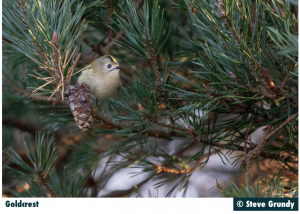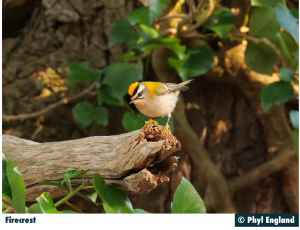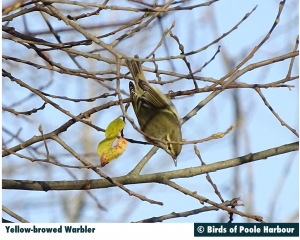Much like the flocks of hardy thrushes we discussed last week, these long, dark and often dangerous journeys are also undertaken by their diminutive counterparts. Possibly owing of their size, it’s hard to get your head around the fact that thousands of tiny Goldcrests arrive from northern Europe, crossing the North Sea to overwinter in the UK. These minute gems are Europe’s smallest bird and are readily encountered as a breeding species across the UK during the summer. However, each autumn sees a mass Goldcrest arrival from Northern Europe as birds depart from the plunging temperatures, settling here for the winter.
Minute size, fine bill and short tail help to identify Goldcrest in the field. The plumage is pale green above and off-white below, with a black bordered head crest, yellow in females and admixed orange in males. An hyperactive feeder, Goldcrests restlessly flit along branches, often hanging tit-like in search of small insects among the foliage, regularly making short flights between trees. While feeding, Goldcrests flicks their wings and give a high-pitched see-see-see call.

Found across any suitable breeding habitat throughout the harbour during the summer, Goldcrest favour the large stands of coniferous woodland along the southern and western shores of Poole Harbour. Arne, Upton Country Park, Canford Heath, Sandbanks, Studland, Middlebere and Lytchett Bay are all excellent sites to go in search of breeding birds locally. Even common garden evergreen hedging leylandii can attract Goldcrests, but birds only tend to visit our more urban gardens during cold snaps, when foraging for natural food sources becomes more challenging. During October, large numbers grace our woodlands and hedgerows around the harbour, associating with various warbler and mixed tit flocks. The headlands around Ballard and along the Studland peninsular support large falls in October during irruption years. Working the surrounding gorse and bramble bushes in late October can reveal the newly-arrived visitors as they begin their frantic search for food, calling constantly to each other and sheltering from the wind.
Goldcrest
Firecrests also travel these vast distances, but in much lower numbers than their golden cousins – which for a bird weighing a mere 5 grams is simply remarkable! The more striking of the two, Firecrests display handsome black, white and orange head markings and vivid green plumage, which makes spotting them on a cold October morning a real joy.

Most easily located in March and October/November when our local breeding populations are supplemented by migrants from mainland Europe, with ringing recoveries revealing French, Belgian, Dutch, German and and Spanish origin. In Poole harbour, Firecrests seem to favour the southern-most regions of the harbour. That said, Upton Country Park, Lytchett Heath, Fleets Corner and even Poole Park can all feature passage Firecrest, with holly and ivy serving as their favoured habitat. During the summer, recent breeding success at numerous sites including Arne and Brownsea Island indicate that Firecrest are now building a small but growing population within the harbour. Note the accelerated, rising pitch of the Firecrest call below, compared to the more constant pitch of Goldcrest calls, which are delivered in a uniform series.
Firecrest
Although not a crest, another tiny green jewel has already begun making an appearance this month in the shape of the Yellow-browed Warbler. Fifty years ago Yellow-browed Warbler were an extreme rarity to the UK, and needed a description written to the BBRC (British Birds Rarity Committee) for the report to be considered for acceptance. However in recent years, these Siberian migrants are rapidly becoming familiar visitors to our shores in October, with between 10-20 logged each year along the Dorset coastline each autumn. They too migrate at night, although they are seldom recorded calling during the hours of darkness. Instead, their presence is typically given away as they make landfall at dawn, giving their distinctive, high-pitched tsoeest call from stands of sycamore trees. Birds have already been recorded at Lytchett Bay, Holes Bay and Canford Heath this autumn. Scanning through Long-tailed Tit flocks anywhere around the harbour could yield a Yellow-browed Warbler in the coming days and weeks!

Yellow-browed Warbler
Spring migration is in full swing with many areas of the harbour getting lively! The Forster’s Tern showed…
Find out moreApologies for the delay in getting today’s sightings online. Exciting news from the Osprey nest this afternoon with…
Find out more© 2025 Birds of Poole Harbour Registered Charity No. 1152615